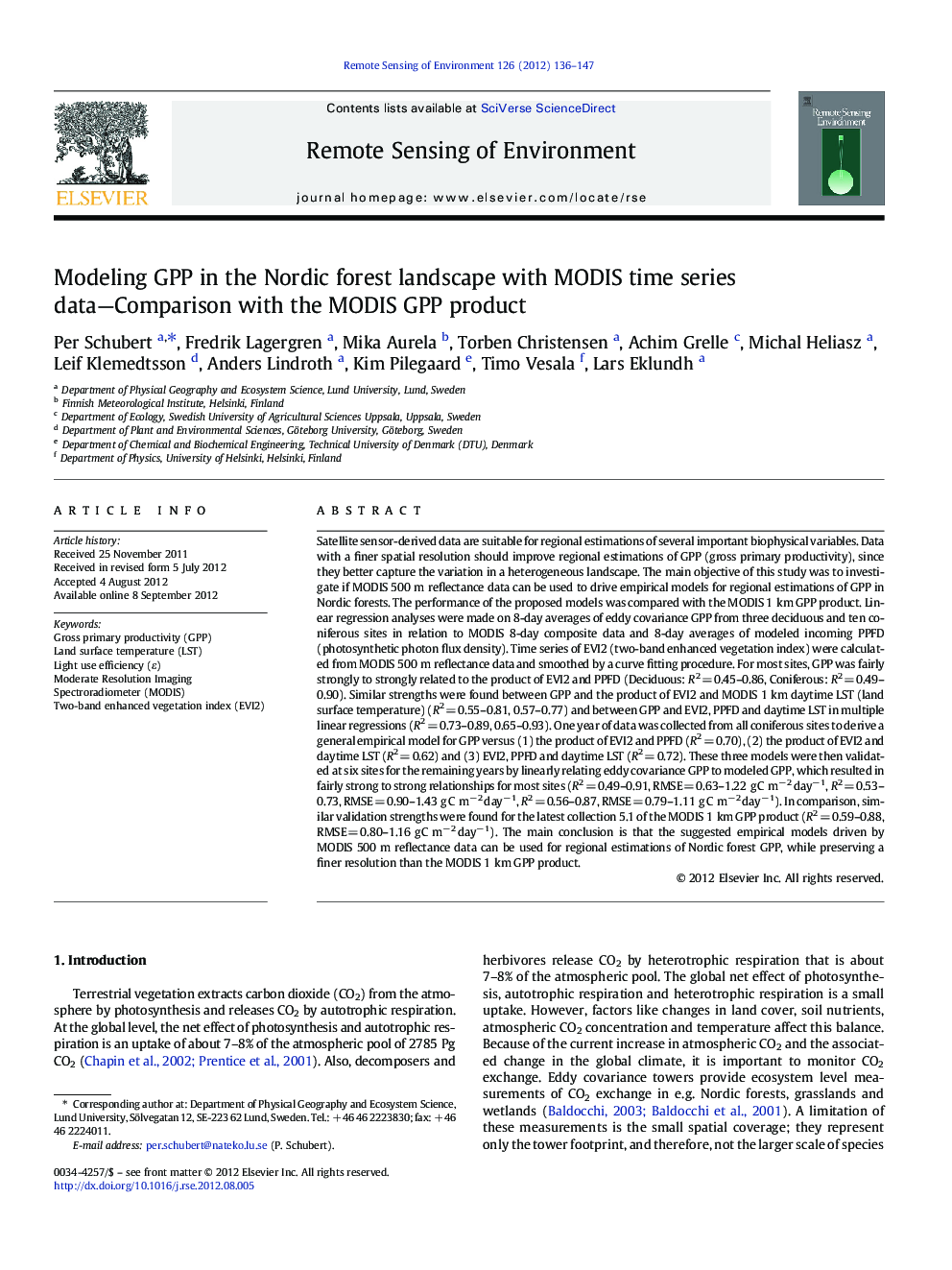| کد مقاله | کد نشریه | سال انتشار | مقاله انگلیسی | نسخه تمام متن |
|---|---|---|---|---|
| 4459068 | 1621274 | 2012 | 12 صفحه PDF | دانلود رایگان |

Satellite sensor-derived data are suitable for regional estimations of several important biophysical variables. Data with a finer spatial resolution should improve regional estimations of GPP (gross primary productivity), since they better capture the variation in a heterogeneous landscape. The main objective of this study was to investigate if MODIS 500 m reflectance data can be used to drive empirical models for regional estimations of GPP in Nordic forests. The performance of the proposed models was compared with the MODIS 1 km GPP product. Linear regression analyses were made on 8-day averages of eddy covariance GPP from three deciduous and ten coniferous sites in relation to MODIS 8-day composite data and 8-day averages of modeled incoming PPFD (photosynthetic photon flux density). Time series of EVI2 (two-band enhanced vegetation index) were calculated from MODIS 500 m reflectance data and smoothed by a curve fitting procedure. For most sites, GPP was fairly strongly to strongly related to the product of EVI2 and PPFD (Deciduous: R2 = 0.45–0.86, Coniferous: R2 = 0.49–0.90). Similar strengths were found between GPP and the product of EVI2 and MODIS 1 km daytime LST (land surface temperature) (R2 = 0.55–0.81, 0.57–0.77) and between GPP and EVI2, PPFD and daytime LST in multiple linear regressions (R2 = 0.73–0.89, 0.65–0.93). One year of data was collected from all coniferous sites to derive a general empirical model for GPP versus (1) the product of EVI2 and PPFD (R2 = 0.70), (2) the product of EVI2 and daytime LST (R2 = 0.62) and (3) EVI2, PPFD and daytime LST (R2 = 0.72). These three models were then validated at six sites for the remaining years by linearly relating eddy covariance GPP to modeled GPP, which resulted in fairly strong to strong relationships for most sites (R2 = 0.49–0.91, RMSE = 0.63–1.22 g C m− 2 day− 1, R2 = 0.53–0.73, RMSE = 0.90–1.43 g C m− 2 day− 1, R2 = 0.56–0.87, RMSE = 0.79–1.11 g C m− 2 day− 1). In comparison, similar validation strengths were found for the latest collection 5.1 of the MODIS 1 km GPP product (R2 = 0.59–0.88, RMSE = 0.80–1.16 g C m− 2 day− 1). The main conclusion is that the suggested empirical models driven by MODIS 500 m reflectance data can be used for regional estimations of Nordic forest GPP, while preserving a finer resolution than the MODIS 1 km GPP product.
► Study of MODIS data-driven models for regional estimations of Nordic forest GPP
► The main conclusion is that the models can be used for regional estimations of GPP.
► The models did not account for between-site differences in model parameter values.
► The models performed well and similar to the performance of the MODIS GPP product.
► The models better capture the landscape heterogeneity than the MODIS GPP product.
Journal: Remote Sensing of Environment - Volume 126, November 2012, Pages 136–147